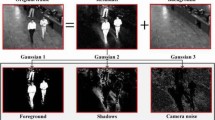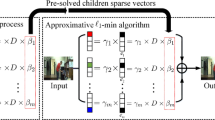Abstract
We present three stages of a novel backgrounds subtraction method in this paper: a new pixel-block based randomized arrangement is utilized to preprocess all the frame images, so that low-rank property of background and sparsity of foreground can be separated more easily; different foreground regions have different sparsity, we use a set of adaptive parameters for subtracting foregrounds according to the variances of frame pixels; finally, background model is built via an improved low-rank and block-sparse matrix decomposition based on the proposed adaptive pixel-block background subtraction. All these key measurements guarantee the considerable performance in background subtraction, which are also demonstrated in our experimental results.










Similar content being viewed by others
References
Barnich O, Van Droogenbroeck M (2009) Vibe: a powerful random technique to estimate the background in video sequences. In: 2009 IEEE international conference on acoustics, speech and signal processing, 2009 ICASSP, pp 945–948
Barnich O, Van Droogenbroeck M (2011) Vibe: a universal background subtraction algorithm for video sequences. IEEE Trans Image Process 20(6):1709–1724
Bengio S, Pereira F, Singer Y, Strelow D (2009) Group sparse coding. In: International conference on neural information processing systems, pp 82–89
Brutzer S, Höferlin B, Heidemann G (2011) Evaluation of background subtraction techniques for video surveillance. In: 2011 IEEE conference on computer vision and pattern recognition (CVPR). IEEE, pp 1937–1944
Cai JF, Candès EJ, Shen Z (2010) A singular value thresholding algorithm for matrix completion. SIAM J Optim 20(4):1956–1982
Choudhury SK, Sa PK, Padhy RP, Sharma S, Bakshi S (2018) Improved pedestrian detection using motion segmentation and silhouette orientation. Multimedia Tools and Applications 77(11):13075–13114
Combettes PL, Pesquet JC (2008) A douglascrachford splitting approach to nonsmooth convex variational signal recovery. IEEE J Sel Top Sign Proces 1(4):564–574
Cui X, Liu Q, Metaxas D (2009) Temporal spectral residual: fast motion saliency detection. In: International conference on multimedia 2009, Vancouver, British Columbia, Canada, October, pp 617– 620
Elgammal A, Duraiswami R, Harwood D, Davis LS (2002) Background and foreground modeling using nonparametric kernel density estimation for visual surveillance. Proc IEEE 90(7):1151–1163
Evangelio RH, Patzold M, Sikora T (2012) Splitting Gaussians in mixture models. In: 2012 IEEE 9th international conference on advanced video and signal-based surveillance, pp 300–305
Fadili MJ, Starck JL (2009) Monotone operator splitting for optimization problems in sparse recovery. In: IEEE international conference on image processing, pp 1445–1448
Fadili MJ, Starck JL, Murtagh F (2009) Inpainting and zooming using sparse representations. Comput J 52(1):64–79
Ganesh A, Wright J, Li X, Candes EJ, Ma Y (2010) Dense error correction for low-rank matrices via principal component pursuit. In: 2010 IEEE international symposium on information theory, pp 1513–1517
Gao Z, Cheong LF, Wang YX (2014) Block-sparse rpca for salient motion detection. IEEE Trans Pattern Anal Mach Intell 36(10):1975–87
Gavrila DM (2000) Pedestrian detection from a moving vehicle. In: European conference on computer vision. Springer, pp 37–49
Gavrila DM, Munder S (2007) Multi-cue pedestrian detection and tracking from a moving vehicle. Int J Comput Vis 73(1):41–59
Goyette N, Jodoin PM, Porikli F, Konrad J, Ishwar P (2012) Changedetection.net: a new change detection benchmark dataset. In: Computer vision and pattern recognition workshops, pp 1–8
Guo JM, Hsia CH, Liu YF, Shih MH, Chang CH, Wu JY (2013) Fast background subtraction based on a multilayer codebook model for moving object detection. IEEE Trans Circuits Syst Video Technol 23(10):1809–1821
Gutchess D, Trajkovics M, Cohen-Solal E, Lyons D, Jain AK (2001) A background model initialization algorithm for video surveillance. In: 8th IEEE international conference on computer vision, 2001. ICCV 2001. Proceedings. IEEE, vol 1, pp 733–740
Guyon C, Bouwmans T, Zahzah EH (2012) Foreground detection via robust low rank matrix decomposition including spatio-temporal constraint. In: Asian conference on computer vision, pp 315– 320
Guyon C, Bouwmans T, Zahzah EH (2012) Foreground detection via robust low rank matrix factorization including spatial constraint with iterative reweighted regression. In: 2012 21st international conference on pattern recognition (ICPR), pp 2805–2808
Guyon C, Bouwmans T, Zahzah EH (2012) Moving object detection via robust low rank matrix decomposition with irls scheme. In: International symposium on visual computing, pp 665–674
Haines TSF, Xiang T (2014) Background subtraction with dirichletprocess mixture models. IEEE Trans Pattern Anal Mach Intell 36(4):670–683
Hale ET, Yin W, Zhang Y (2008) Fixed-point continuation for l1-minimization: methodology and convergence. SIAM J Optim 19(3):1107–1130
Han B, Davis LS (2012) Density-based multifeature background subtraction with support vector machine. IEEE Trans Pattern Anal Mach Intell 34(5):1017–1023
Ivanov Y, Bobick A, Liu J (2000) Fast lighting independent background subtraction. Int J Comput Vis 37(2):199–207
Lan X, Ma A, Yuen PC, Chellappa R (2015) Joint sparse representation and robust feature-level fusion for multi-cue visual tracking. IEEE Trans Image Process Publ IEEE Signal Process Soc 24(12): 5826
Lan X, Ma AJ, Yuen PC (2014) Multi-cue visual tracking using robust feature-level fusion based on joint sparse representation. In: Computer vision and pattern recognition, pp 1194–1201
Lan X, Ye M, Yuen P, Zhang S, Zhou H (2018) Modality-correlation-aware sparse representation for rgb-infrared object tracking. Pattern Recognition Letters. https://doi.org/10.1016/j.patrec.2018.10.002
Lan X, Ye M, Zhang S, Yuen PC (2018) Robust collaborative discriminative learning for rgb-infrared tracking. National Conference on Artificial Intelligence
Lan X, Yuen PC, Chellappa R (2017) Robust mil-based feature template learning for object tracking. In: National conference on artificial intelligence, pp 4118–4125
Lan X, Zhang S, Yuen PC (2016) Robust joint discriminative feature learning for visual tracking. In: International joint conference on artificial intelligence, pp 3403–3410
Lan X, Zhang S, Yuen PC, Chellappa R (2018) Learning common and feature-specific patterns: a novel multiple-sparse-representation-based tracker. IEEE Trans Image Process 27(4):2022–2037
Li C, Wang X, Zhang L, Tang J, Wu H, Lin L (2017) Weighted low-rank decomposition for robust grayscale-thermal foreground detection. IEEE Trans Circuits Syst Video Technol 27(4):725– 738
Li L, Huang W, Gu YH, Tian Q (2004) Statistical modeling of complex backgrounds for foreground object detection. IEEE Trans Image Process A Publ IEEE Signal Process Soc 13(11):1459
Lin Z, Chen M, Ma Y (2010) The augmented lagrange multiplier method for exact recovery of corrupted low-rank matrices. arXiv:http://arXiv.org/abs/1009.5055
Liu L, Cheng L, Liu Y, Jia Y, Rosenblum DS (2016) Recognizing complex activities by a probabilistic interval-based model. In: 30th AAAI conference on artificial intelligence, pp 1266–1272
Liu X, Zhao G, Yao J, Qi C (2015) Background subtraction based on low-rank and structured sparse decomposition. IEEE Trans Image Process 24(8):2502–2514
Liu Y, Nie L, Han L, Zhang L, Rosenblum DS (2016) Action2activity: recognizing complex activities from sensor data. In: 24th international joint conference on artificial intelligence, pp 1617– 623
Liu Y, Nie L, Liu L, Rosenblum DS (2016) From action to activity: sensor-based activity recognition. Neurocomputing 181:108–115
Liu Y, Zhang L, Nie L, Yan Y, Rosenblum DS (2016) Fortune teller: predicting your career path. In: 30th AAAI conference on artificial intelligence, pp 1266–1272
Maddalena L, Petrosino A (2008) A self-organizing approach to background subtraction for visual surveillance applications. IEEE Trans Image Process 17 (7):1168–1177
Oliver NM, Rosario B, Pentland AP (2000) A bayesian computer vision system for modeling human interactions. IEEE Trans Pattern Anal Mach Intell 22(8):831–843
Park MW, Kim JI, Lee YJ, Park J, Suh W (2017) Vision-based surveillance system for monitoring traffic conditions. Multimedia Tools and Applications 76(23):25343–25367
Reddy V, Sanderson C, Lovell BC (2013) Improved foreground detection via block-based classifier cascade with probabilistic decision integration. IEEE Trans Circuits Syst Video Technol 23(1): 83–93
Rodriguez P, Wohlberg B (2013) Fast principal component pursuit via alternating minimization. In: 2013 20th IEEE international conference on image processing (ICIP), pp 69–73
Shu X, Porikli F, Ahuja N (2014) Robust orthonormal subspace learning: efficient recovery of corrupted low-rank matrices. In: Proceedings of the IEEE conference on computer vision and pattern recognition, pp 3874–3881
Sun L, Sheng W, Liu Y (2015) Background modeling and its evaluation for complex scenes. Multimedia Tools and Applications 74(11):3947–3966
Tang G, Nehorai A (2011) Robust principal component analysis based on low-rank and block-sparse matrix decomposition. In: National conference on information sciences and systems, pp 1–5
Tsai DM, Lai SC (2009) Independent component analysis-based background subtraction for indoor surveillance. IEEE Trans Image Process 18(1):158–167
Unzueta L, Nieto M, Cortés A, Barandiaran J, Otaegui O, Sánchez P (2012) Adaptive multicue background subtraction for robust vehicle counting and classification. IEEE Trans Intell Transp Syst 13(2):527–540
Vacavant A, Chateau T, Wilhelm A, Lequièvre L (2012) A benchmark dataset for outdoor foreground/background extraction. Int Conf Comput Vis 7728:291–300
Van Droogenbroeck M, Paquot O (2012) Background subtraction: experiments and improvements for vibe. In: 2012 IEEE computer society conference on computer vision and pattern recognition workshops (CVPRW), pp 32–37
Wang N, Yao T, Wang J, Yeung DY (2012) A probabilistic approach to robust matrix factorization. In: ECCV’12 Proceedings of the 12th European conference on Computer Vision - Volume Part VII, pp 126–139
Wold S, Esbensen K, Geladi P (1987) Principal component analysis. Chemometr Intell Lab Syst 2(1-3): 37–52
Wright J, Ganesh A, Rao S, Peng Y, Ma Y (2009) Robust principal component analysis: exact recovery of corrupted low-rank matrices via convex optimization. In: Advances in neural information processing systems, pp 2080–2088
Xue Y, Guo X, Cao X (2012) Motion saliency detection using low-rank and sparse decomposition. In: IEEE International conference on acoustics, speech and signal processing, pp 1485– 1488
Yang MH, Huang CR, Liu WC, Lin SZ, Chuang KT (2015) Binary descriptor based nonparametric background modeling for foreground extraction by using detection theory. IEEE Trans Circuits Syst Video Technol 25(4):595–608
Yi X, Park D, Chen Y, Caramanis C (2016) Fast algorithms for robust pca via gradient descent. Neural Information Processing Systems, pp 4152–4160
Yuan X, Yang J (2009) Sparse and low-rank matrix decomposition via alternating direction methods preprint 12
Zhou T, Tao D (2013) Shifted subspaces tracking on sparse outlier for motion segmentation. In: IJCAI ’13 Proceedings of the 23rd international joint conference on artificial intelligence, pp 1946– 1952
Acknowledgments
The authors would like to thank the editor and the anonymous reviewers for their valuable and helpful comments, as well as the important guiding significance to our researches. The authors also acknowledge Yichao Cao from Southeast University for his useful proofreading and suggestions.
This work was supported by the National Natural Science Foundation of China (No. 61871123), Key Research and Development Program in Jiangsu Province (No. BE2016739) and a Project Funded by the Priority Academic Program Development of Jiangsu Higher Education Institutions.
Author information
Authors and Affiliations
Corresponding author
Additional information
Publisher’s Note
Springer Nature remains neutral with regard to jurisdictional claims in published maps and institutional affiliations.
This work was supported by the National Natural Science Foundation of China (No.61871123), Key Research and Development Program in Jiangsu Province (No.BE2016739) and a Project Funded by the Priority Academic Program Development of Jiangsu Higher Education Institutions.
Rights and permissions
About this article
Cite this article
Wu, X., Lu, X. Adaptive pixel-block based background subtraction using low-rank and block-sparse matrix decomposition. Multimed Tools Appl 78, 16507–16526 (2019). https://doi.org/10.1007/s11042-018-7037-7
Received:
Revised:
Accepted:
Published:
Issue Date:
DOI: https://doi.org/10.1007/s11042-018-7037-7




